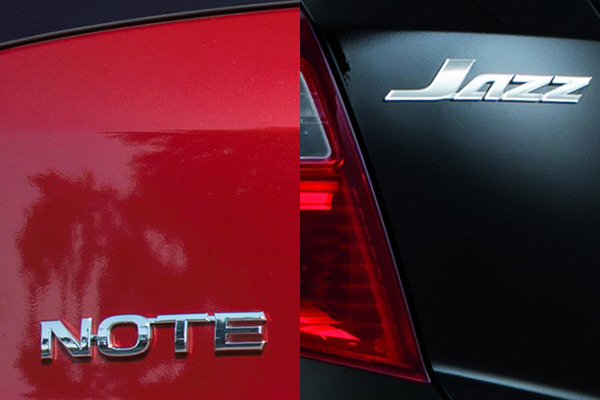Nissan Note vs Honda Jazz – which is best?
June 30, 2014 by Paranjay Dutt

The Nissan Note and Honda Jazz are two small Japanese cars that score highly on practicality while keeping running costs low, and youcould spend anywhere between 10,000 and20,000 on one of them. The Jazz has been on the market longer than the bigger Note, whichhas a fresher-lookingdesign.
Both offer practicality and flexibility in well-built packages, butthereare considerable differences between the Note and Jazz when it comes toengine choices, interior quality and running costs.
But which should you buy? We’ve cast our criticaleye over both to give you our definitive answer.

Driving

The Note and the Jazz both offer easy but not very engaging drives. The Jazz has light steering, which makes it easy to zip around busy streets, but the steering lacks feel during faster driving not a huge downfall in a car that’ll likelyspend most of its time in urban areas, but worth knowing all the same.The Jazz doesoffera decent ride,so ferrying your friends and older family members around town won’t be a jarring experience.
The Nissan Note also drives well in the city. The steering is a little heavier than the Jazz,which makes it feel slightly more involving to drive, but you’ll be disappointed if you’re expecting sportscar levels of excitement.

Motorway journeys aren’t a speciality of either cars, but expert reviews suggest the Honda is decently refined for those, while the Note doesn’t feel at home when driven at higher speeds.
Styling

Let’s start with the Honda Jazz. The looks might not rival the best-looking hatchbacks on sale at the moment, but in a market where practicality is more important than aesthetics, the Jazz doesn’t look out of place. Next to the newer Note, you might expect the Honda to feel a bit outdated, but it doesn’t really possibly because the Jazz has a simpler design that dates more gracefully than snazzier competitors. Both cars incorporate large areas of glass into their designs, which means the insides of both feel airy and spacious.

Interior and practicality
Both vehicles are surprisingly roomy inside, have practical seating options, and simple dashboard layouts with easily reachable controls that wont have you swearing while trying to change radio station and dodge city traffic.

We think the Jazz’s interior is more likeable than the Notes, thanks to a modern-looking steering wheel and bolder looking dials. The Jazz’s dashboard-mounted entertainment system takes up a big part of the centre console, and like most other Hondasthe car feelswell put together without any rattles or squeaks. In terms of seating, the Jazzs rear seats can be folded to offer a flat luggage bay, which is a boon if you’re planning to carry large boxes or taking the occasional trip to the garden centre.

The Note is also impressively spacious for its size. Its a bit longer than the Jazz, and has more space in the back. With the rear seats down, the Notes boot capacity expands to 411 litres. The dashboard layout doesn’t look as striking as that of the Jazz, but it still does the job and hasn’t put reviewers off recommending the car. Click here to see what we thought about the Note when it was unveiled.
Engines
With its slightly thirsty petrol-only line-up, Hondas Jazz doesn’t have the same range of engines as the Note.Needless to say, the petrol engines are well-refined and carry the trademark Honda reliability factor too, but the lack of a diesel unit doesn’t help the Jazz’s case as a cheap-to-run city car, especially when the competition offers more frugal options.

If you do plump for the Jazz you’ll get the choice of a 1.2-litre petrol, a 1.4-litre petrol, and a hybrid unit based on a 1.3-litre petrol engine. The battery packs fit neatly under the floor of the car so you don’t need to worry about losing boot space if you go for the hybrid.The 1.2- and 1.4-litreengines come with manual gearboxes as standard but an automatic CVT (Continuously Variable Transmission similar to the gearbox in a scooter) is available on the 1.4. The hybrid version of the Jazz only gets the CVT gearbox.
The Nissan Note comes with two engine options, a 1.2-litre, three-cylinder petrol and a 1.5-litre diesel. The petrol engine is available with manual or automatic CVT gearboxes, but the diesel variant is available only with a manual box.

Value for money and running costs
The two petrol units in the Jazz aren’t terribly economical and although the Hybrid version will return a claimed 63mpg, it’s no match for the Notes 80mpg diesel engine.
In case of the Note, both the 1.2-litre petrol and 1.5-litre diesel engines are more efficient than Honda’s units.
Prices for the Honda Jazz start at about 11,695 for the 1.2 i-VTEC S variant and go up to 20,245 for the hybrid 1.3 IMA HX-T version. If you consider the 1.4-litre petrol model, then expect to pay about 14,300 for the base i-VTEC ES version.
Theres a bigger range of trim levels for the Note, from the entry-level 1.2 Visia limited edition priced at 9,995 to the base 1.5dCi Visia diesel priced from 14,100. The top-spec petrol costs 17,100, which is the same as the fully equipped version of the 1.5-litre diesel model.
Verdict
It’s clear the Nissan Note has the upper hand,beit in terms of interior space or fuel efficiency.

The Jazz, which is due a replacement soon, holds it well against the bigger Note, but the lack of a diesel engine makes things tough for the small Honda. The quality of the interior, the flat loading area at the rear (with the back seats folded, of course), and Honda’s trademark refinement and reliability do make up for the negatives.
The fact that the Jazz can still compete against a relatively new car is commendable, but with a newer version on its way, we can’t wholeheartedly recommend the current one. Wed go for the Note.















